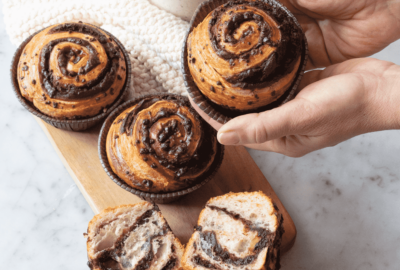Mintel values the UK gluten-free market at £210million (June 2015) and it’s showing no signs of slowing down as awareness and diagnoses of coeliac disease grows. In fact 13% of the UK population now say they avoid gluten – the highest in Europe. With Coeliac UK’s Awareness Week taking place next month (May 9-15), we’ve asked several chefs and industry experts to share their tips and knowledge about gluten-free catering…
Darren Chapman, food development chef, Nestlé Professional
• USE PRODUCTS THAT EVERYONE CAN EAT: Focusing on ingredients that are suitable for all diners is far easier – and much quicker – than creating separate versions of popular dishes.
• GET STRICT ON CROSSCONTAMINATION: There are very few kitchens that are completely gluten-free, as there is normally flour in all kitchens and cross-contamination can occur but there are simple steps you can take to avoid gluten contamination, such as using colour coded gloves to prepare glutenfree dishes and storing ingredients in separate sealed containers.
• KNOW YOUR LABELS: It may sound obvious, but check labels carefully. Products described as wheat-free are not necessarily free from gluten.
Paul Bates, head chef, OXBO, Bankside, London Gone are the days where a slice of gluten-free bread will suffice. The experienced coeliac traveller expects so much more, which is a challenge every modern day chef now faces. Our breakfast menu was the first thing to take the gluten-free hit. We now have four different breads, a selection of breakfast scones, muffins, and a variety of fresh fruit, yogurt, organic grains and seeds available. We make gluten-free muesli, which contains rice and oat products as well as a signature home-roasted granola but, more importantly, our Full English Breakfast is also gluten-free, which is not as simple as you’d think. For lunch and dinner, I didn’t want to offer a menu that our coeliac guests would be limited in their choice so I visited my local suppliers at Borough Market and set myself the task of finding alternative gluten-free ingredients for each of our dishes. Some of the changes were simple, for example, the noodle and pasta dishes can be substituted with rice noodles or cornbased pasta, sliced celeriac replaces lasagne sheets and spaghetti made from carrot, leek and courgette replaces flour-based traditional linguini. Our sauces are thickened with arrowroot, which, unlike cornflour, thickens without clouding the sauce, all dressings are void of gluten-filled mustards and we only use vinegars and oils that we can guarantee their provenance. Finger food and bar snacks didn’t escape the cull either; our ever-popular fish cakes and croquettes are coated in crushed rice crispies, cornflakes or gram flour before frying, which works an absolute dream.
Kathryn Miller, Coeliac UK head of food policy
• TRY OUT ALTERNATIVE GRAINS: there are lots of alternatives that are naturally gluten-free. Quinoa, corn, amaranth and buckwheat are all gluten-free and can be used in a variety of dishes, from salads to mueslis and cakes.
• EXPERIMENT WITH DIFFERENT FLOURS: try using potato starch or corn flour to thicken sauces or gluten-free flour for batters and coatings. A simple ingredient change could remove gluten from a range of dishes on your menu.
• MEAT, FISH AND POULTRY DON’T CONTAIN GLUTEN, even when the animal has been fed on a gluten-containing diet.
• DON’T FORGET THE DESSERT! A fruit salad can be an easy choice for dessert, but your gluten-free guests can get tired of the same offering. Gluten-free versions of cheesecakes, crumbles and cakes can be made using ingredients like gluten-free flour, polenta and ground almonds.
Lucinda Bruce-Gardyne, founder of Genius Gluten When it comes to gluten-free baking, it is amazing what you can create with an understanding of how to blend gluten-free dry ingredients to imitate the behaviour of wheat or other gluten-rich ingredients. Successfully replicating the function of wheat flour in gluten-free cooking involves blending particular ingredients, selected for their range of properties, to create the familiar taste and appearance you expect from a cake, a pastry crust, a slice of bread or a sauce. This might include:
ARROWROOT Used mainly as a thickening agent for clear sauces but its fine texture also makes it ideal for use in very light-textured baked products
BUCKWHEAT FLOUR A very useful flour for gluten-free baking as it helps to bind the dough and gives it a crunch when baked
CHESTNUT FLOUR A fine, soft light-brown flour with a gentle, nutty sweetness, it is rich in starch, protein, vitamins and minerals. It adds a natural earthy sweetness and light-brown colour to cakes, bread and biscuits
POTATO STARCH Neutralflavoured flour and very important in gluten-free baking for creating a strong, fluffy structure and a light, soft eating experience in bread and cakes. It is also an effective sauce thickener
RICE FLOUR A versatile flour for thickening sauces or coating foods for frying, or as part of the flour blend used to make gluten-free bread, cakes, biscuits and pastry
Simon Briggs, head chef, Queen Ethelburga’s School, York When writing menus for the students, it is important for us to ensure that anyone with specific dietary requirements is catered for to the same high standards as everyone else. Where possible we will adapt dishes to meet requirements, for example using gluten-free pasta, or gluten-free flour for our baking and sauces, or by using alternatives such as quinoa instead of cous cous. Our soups are also all gluten-free as is our gravy and many other sauces. A favourite of everyone’s is our fish and chips every Friday, and we feel it is important that no one misses out on our homemade, golden, crispy batter so a gluten-free batter is always prepared. Our focus is on adapting dishes rather than offering alternatives so that the students always feel included at meal times.
Gareth Bevan head chef, Food by Breda Murphy, Whalley, Lancashire As we all know gluten-free pastry can be somewhat of a nightmare to work with and can be notoriously poor in quality compared to standard pastry recipes. Although there are now products that are being produced to aid the process of making offering pastry such as xanthan and guar gum, I still prefer to look for other alternatives to help bind and create the light, flaky and short result you would often get with good glutenbased flours. For example, in my recipe for sundried tomato and mascarpone tart with basil polenta pastry*, I use finely grated parmesan and polenta. The parmesan not only adds great flavour but also provides a little of the elasticity missing from the absence of gluten and the polenta adds amazing texture as well as providing a good alternative to using all gluten-free pastry.


